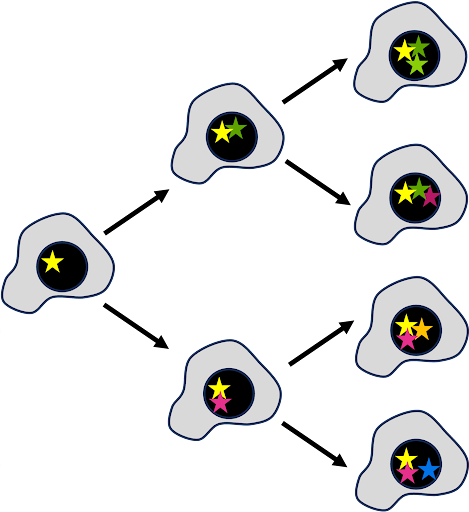Mutations result when the genome is not passed perfectly intact to offspring
In order to pass on genetic information, a parent cell copies its DNA and divides the copies among daughter cells in meiosis or mitosis. The process must be completed with fidelity, ensuring that the genomic sequence of daughter cells is the same as the parent. But in practice, errors occur: there is about one mutation with every round of cell division, although this varies by both species and cell type[1][2]. This mutation in cell division is illustrated in Figure 1.
One mutation per cell division doesn’t sound like a lot! But to grow a mature human body requires about 3.5×1013 (35 trillion) cells. We could therefore hypothesize that it takes about 45 cycles of cell divisions to get from a one-celled zygote to a mature human body, assuming every daughter cell survives and divides again. That means that any individual cell in your body may have about 45 mutations that are different from the fertilized egg! But those mutations are not necessarily the same 45 mutations as in other cells of the body. In Figure 1, even after just two rounds of cell division, the four daughter cells have different combinations of mutations.
To note: this also means that any egg or sperm that your body produces also has mutations compared to your original zygotic genome. These would give rise to de novo mutations in offspring: mutations that were not seen in previous generations.

By some estimates, over the course of a human lifetime, there are cumulatively about 1016 cell divisions[3]. This means that individual cells in an individual can be different from one another, with as many as 1016 differences collectively found in the human body! But most of these differences that accumulate over the course of a lifetime do not dramatically impact phenotype.
This module is divided into two parts. Part I looks at types of mutations and the effects of mutations. Part II looks at the mechanisms by which replication errors and DNA damage lead to mutation.
A preview of how mutations can be classified is listed below in Table 1.
| Ways to classify | Examples |
| Type of cell affected | Germline Somatic |
|---|---|
| Change to DNA Sequence | Base substitution (transition or transversion) Insertion Deletion Chromosomal rearrangement |
| Change to gene function | Neutral Gain of function Loss of function |
| Effect on phenotype | Dominant Recessive |
| Change to protein coding sequence | Silent Missense Nonsense Frameshift |
| Effect on other mutations | Intragenic suppressor Intergenic suppressor |
Media Attributions
- Mutations accumulate © Amanda Simons is licensed under a CC BY-SA (Attribution ShareAlike) license
- Werner, B. et al. Measuring single cell divisions in human tissues from multi-region sequencing data. Nat. Commun. 11, 1035 (2020). ↵
- Lynch, M. Evolution of the mutation rate. Trends Genet. TIG 26, 345–352 (2010). ↵
- Number of cell divisions in an average human - Human Homo sapiens - BNID 100379. https://bionumbers.hms.harvard.edu/bionumber.aspx?id=100379. ↵

